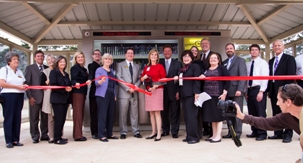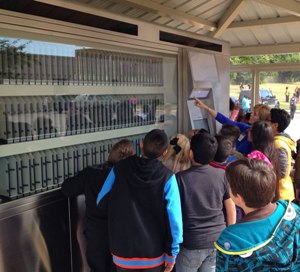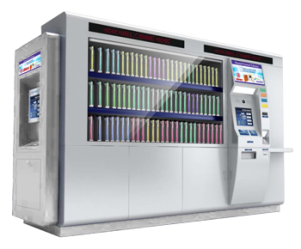
Pioneer Library System held a ribbon cutting ceremony for the new 24-hour vending library on October 29.
Oklahoma’s Pioneer Library System (PLS) this week became the first library in the U.S. to debut Envisionware’s new 24-Hour Library. Officials plan to use two new vending units to offer 24 hour pickup for reserve materials at a small new branch near a busy shopping area, and to enhance access to materials in another location near a community center and a middle school.
The vending libraries help PLS resolve a need that it had been working to address since 2008, when a referendum to build new branches on the east and west sides of Norman, OK, failed by a very narrow margin, explained PLS Assistant Director and 2008 LJ Mover & Shaker Lisa Wells. Shortly afterward, the economy tanked, and it has been difficult to build momentum for a new referendum ever since.
“Citizens have just been, I would say, patient for a while,” she said.
After the unfortunate liquidation of Borders in 2011, PLS began addressing the issue by purchasing the company’s vacated store on the west side of Norman to house administrative offices and a small 6,700 square foot branch, which will open on November 1. Recently, a city-council member suggested that PLS lease space for a new branch in a strip-mall location on the city’s east side, but it “wasn’t a location that the library system felt met our expectations for where and how we wanted to deliver service,” Wells said.
Instead, when Wells had a chance to see Envisionware’s 24-Hour Library at a recent COSUGI conference, “We very quickly realized that it was a direction that we wanted to go,” she said.
On the west side, the new vending unit will help free up space within the new branch. For now, it will be used exclusively to help manage reserves.
“The branch library was so small that we didn’t want to take up floor space for reserve items,” Wells explained. “Because it is across the street from the mall, it’s in an area that has lots of restaurants and a couple of hotels. It’s a high foot traffic area. We felt as though people might want to pick up their reserves during times when the library wasn’t open. We are also moving our [DVD, CD, and video game vending] MediaBank out there, which is very similar to a RedBox.”
PLS does not currently have a bookmobile program, but felt that a 24-hour vending unit would be a better way to enhance service on Norman’s east side, in an area where a market segmentation study had revealed a high penetration of library cardholders, as well as high library circulation, with no nearby branch. There, the unit was installed adjacent to a middle school and a city recreation center.
Balanced Collection

Kids from nearby Irving Middle School checked out the new vending library before it was stocked with books and media
Once integrated with the library system’s ILS via SIP2 or NCIP, the $200,000 units are treated as a new branch offering 400 books, audiobooks, DVDs, and other media for checkout, and storing up to 1,000 returned items in a 14-bin sorter.
With the east side unit, “We plan to have what we would consider a really balanced collection—a variety of formats, a variety of reading levels and age groups,” Wells said. Although they expect teen and young adult materials to be especially popular thanks to the proximity to the middle school, “We plan to have adult, teen, and children’s print as well as non-print. We are also using the machine as a pickup location, so we will keep some slots available for people who put books on hold and come to the machine to pick up.”
The browsing collection will fluctuate based on how many people use the machine to pick up reserved materials, and how popular titles prove to be. With limited space, PLS expects high turnover.
“We’ll use the resources that we have to evaluate [whether] that collection is turning over at the rate that we want it to, and very quickly we will remove things that aren’t checking out, because it’s prime real estate,” Wells said. “There’s a limited number of items that we can have there, and our expectation is to have a collection there that is turning over often.”
Simplifying checkout and returns, the system can read library card barcodes and detect RFID tags. It also offers nearby users a Wi-Fi access point, and enables patrons to pay fees or fines with a credit card. The 24-Hour Library and its contents are protected by a remotely-accessible four camera security system with a 30-day DVR recorder and a door/system alarm. To reserve materials, patrons can search the library’s catalog on a 17-inch industrial display with a kiosk keyboard and mouse, or learn more about library programs via a 32-inch industrial touch screen. Wells already anticipates using the touch screen to highlight events at other branches, or events that PLS is now planning to host at the nearby recreation center.
“We’ll be able to bring some programming to that recreation center that we feel will also benefit library users in that area. So, we’ll do some story times, some summer reading programs at the rec center there that is just adjacent to the 24-hour library.”
Coolness Factor
 Although PLS was the first to launch the new Envisionware library with a ribbon cutting at the east side location on October 29, three other systems are following close behind. Fresno County Public Library, the Milwaukee Public Library, and San Diego County Library soon will be going live with Envisionware 24-Hour Libraries as well.
Although PLS was the first to launch the new Envisionware library with a ribbon cutting at the east side location on October 29, three other systems are following close behind. Fresno County Public Library, the Milwaukee Public Library, and San Diego County Library soon will be going live with Envisionware 24-Hour Libraries as well.
“All of these libraries are share the fact that they have patrons that need services at different hours, they have patrons that work late, and they’re trying to find a way to deliver services closer to patrons,” said Envisionware CEO Mike Monk.
Monk also believes that the units may attract new library users with a sense of curiosity, and then help the library retain those new patrons with the vending library’s convenience.
“The coolness factor of the machine is drawing people to the library in a new and innovative way,” Monk said. “They’re getting to experience the library without actually going there. The belief is, once they have a library card, once they’ve checked out materials, once they understand the convenience and benefit of being able to borrow virtually unlimited information, they’re also going to become aware of what’s going on in the library, learn about summer reading programs, guest speakers, and hopefully, what we’re all going to do is achieve a deeper reach into [groups] that may not be classic library users.”
Very few U.S. library systems have experimented with vending units, but their potential for drawing traffic may be tied to location, local demographics, and even trends beyond a library’s control. In 2008, for example, Contra Costa County Library installed a Library-a-Go-Go machine, made by Sweden-based Distec, to vend print books at a busy Bay Area Rapid Transit (BART) station. The machine was instantly popular, and was used to lend a significant number of books during its first two years, but by 2011, usage began declining, as tablets and e-readers became increasingly popular with San Francisco transit commuters. In addition to the vending unit, CCCL now has marketing campaigns that encourage BART riders to check out ebooks from the library as well.
Wells believes that using these vending units to partner with the community center and supplement existing services at a new branch is a stable long-term plan, and added that all libraries must continue to offer their communities access to traditional resources as they responding to emerging trends.
“I think if libraries are to remain relevant, we must continue to look for innovative solutions that bridge that gap between what the library used to be and what the library of tomorrow will be, and then finding a healthy balance,” she said.


